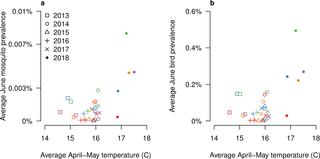当前位置:
X-MOL 学术
›
PLOS Negl. Trop. Dis.
›
论文详情
Our official English website, www.x-mol.net, welcomes your
feedback! (Note: you will need to create a separate account there.)
A quantitative comparison of West Nile virus incidence from 2013 to 2018 in Emilia-Romagna, Italy.
PLOS Neglected Tropical Diseases ( IF 3.4 ) Pub Date : 2020-01-02 , DOI: 10.1371/journal.pntd.0007953 Giovanni Marini 1, 2 , Mattia Calzolari 3 , Paola Angelini 4 , Romeo Bellini 5 , Silvia Bellini 6 , Luca Bolzoni 7 , Deborah Torri 3 , Francesco Defilippo 3 , Ilaria Dorigatti 8 , Birgit Nikolay 9, 10, 11 , Andrea Pugliese 12 , Roberto Rosà 1, 2, 13 , Marco Tamba 6
PLOS Neglected Tropical Diseases ( IF 3.4 ) Pub Date : 2020-01-02 , DOI: 10.1371/journal.pntd.0007953 Giovanni Marini 1, 2 , Mattia Calzolari 3 , Paola Angelini 4 , Romeo Bellini 5 , Silvia Bellini 6 , Luca Bolzoni 7 , Deborah Torri 3 , Francesco Defilippo 3 , Ilaria Dorigatti 8 , Birgit Nikolay 9, 10, 11 , Andrea Pugliese 12 , Roberto Rosà 1, 2, 13 , Marco Tamba 6
Affiliation

|
BACKGROUND
West Nile virus (WNV) transmission was much greater in 2018 than in previous seasons in Europe. Focusing on Emilia-Romagna region (northern Italy), we analyzed detailed entomological and epidemiological data collected in 2013-2018 to quantitatively assess environmental drivers of transmission and explore hypotheses to better understand why the 2018 epidemiological season was substantially different than the previous seasons. In particular, in 2018 WNV was detected at least two weeks before the observed circulation in 2013-2017 and in a larger number of mosquito pools. Transmission resulted in 100 neuroinvasive human cases in the region, more than the total number of cases recorded between 2013 and 2017.
METHODOLOGY
We used temperature-driven mathematical models calibrated through a Bayesian approach to simulate mosquito population dynamics and WNV infection rates in the avian population. We then estimated the human transmission risk as the probability, for a person living in the study area, of being bitten by an infectious mosquito in a given week. Finally, we translated such risk into reported WNV human infections.
PRINCIPAL FINDINGS
The estimated prevalence of WNV in the mosquito and avian populations were significantly higher in 2018 with respect to 2013-2017 seasons, especially in the eastern part of the region. Furthermore, peak avian prevalence was estimated to have occurred earlier, corresponding to a steeper decline towards the end of summer. The high mosquito prevalence resulted in a much greater predicted risk for human transmission in 2018, which was estimated to be up to eight times higher than previous seasons. We hypothesized, on the basis of our modelling results, that such greater WNV circulation might be partially explained by exceptionally high spring temperatures, which have likely helped to amplify WNV transmission at the beginning of the 2018 season.
中文翻译:

意大利艾米利亚-罗马涅地区2013年至2018年西尼罗河病毒发病率的定量比较。
背景西尼罗河病毒(WNV)的传播在2018年比欧洲以前的季节要多得多。以意大利北部的艾米利亚-罗马涅地区为重点,我们分析了2013-2018年收集的详细昆虫学和流行病学数据,以定量评估传播的环境驱动因素,并探索假设以更好地理解2018年流行病学季节与往年有何显着不同。特别是在2018年至2013年至2017年观测到的循环之前至少两周,并在大量蚊子池中检测到了2018年WNV。传播导致该地区发生100例神经侵袭性人类病例,超过2013年至2017年记录的病例总数。方法论我们使用通过贝叶斯方法校准的温度驱动的数学模型来模拟鸟类种群中的蚊子种群动态和WNV感染率。然后,我们估计人为传播的风险为居住在研究区域的人在给定一周内被传染性蚊子叮咬的可能性。最后,我们将这种风险转化为已报道的WNV人感染。主要发现与2013-2017季节相比,2018年蚊虫和禽鸟种群中WNV的估计患病率明显更高,特别是在该区域的东部地区。此外,据估计禽类流行高峰发生的时间更早,与夏末时的急剧下降相对应。高蚊子流行率导致2018年人类传播的预测风险高得多,据估计比以往季节高出八倍。根据建模结果,我们假设如此高的WNV循环可能部分归因于异常高的春季温度,这可能有助于扩大2018赛季初的WNV传播。
更新日期:2020-01-04
中文翻译:

意大利艾米利亚-罗马涅地区2013年至2018年西尼罗河病毒发病率的定量比较。
背景西尼罗河病毒(WNV)的传播在2018年比欧洲以前的季节要多得多。以意大利北部的艾米利亚-罗马涅地区为重点,我们分析了2013-2018年收集的详细昆虫学和流行病学数据,以定量评估传播的环境驱动因素,并探索假设以更好地理解2018年流行病学季节与往年有何显着不同。特别是在2018年至2013年至2017年观测到的循环之前至少两周,并在大量蚊子池中检测到了2018年WNV。传播导致该地区发生100例神经侵袭性人类病例,超过2013年至2017年记录的病例总数。方法论我们使用通过贝叶斯方法校准的温度驱动的数学模型来模拟鸟类种群中的蚊子种群动态和WNV感染率。然后,我们估计人为传播的风险为居住在研究区域的人在给定一周内被传染性蚊子叮咬的可能性。最后,我们将这种风险转化为已报道的WNV人感染。主要发现与2013-2017季节相比,2018年蚊虫和禽鸟种群中WNV的估计患病率明显更高,特别是在该区域的东部地区。此外,据估计禽类流行高峰发生的时间更早,与夏末时的急剧下降相对应。高蚊子流行率导致2018年人类传播的预测风险高得多,据估计比以往季节高出八倍。根据建模结果,我们假设如此高的WNV循环可能部分归因于异常高的春季温度,这可能有助于扩大2018赛季初的WNV传播。









































 京公网安备 11010802027423号
京公网安备 11010802027423号